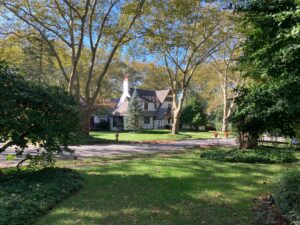Buttonwood at Shrewsbury
It’s true that Shrewsbury is a community steeped in history. But it’s also a community that in its history has been way ahead of its time… Like Buttonwood at Shrewsbury
The first housing development built here in 1926
Buttonwood at Shrewsbury, located off Sycamore Avenue, was designed with all building lots developed around a single oval street. Each site is either 75 or 90 feet with frontage on the road, except for a few irregular lots with a rear width of 200 feet. Some property owners bought two lots, giving them a total frontage of 150 feet.
A local newspaper reported in 1926 that one 75 X 155-foot lot sold for $3,000. Mr. C. Baquet, Jr. purchased it for a Dutch colonial design home he built for an estimated cost of between $13,000 and $15,000.
G.H Nevins was the operator of the development, according to an advertisement for sale of the lots. He sold them with a number of restrictions that were also enticements for purchasers. The ad read “No through traffic, protection for your children and quiet for yourself. Private parks and playgrounds are nearly three acres in extent. Gas, water, electricity, curbs and sidewalks, a shallow brook, gentle grades, beautiful view, masses of flowering shrubs and the “feeling” that develops by living in a place of historic associations.”
Nevins also pointed out that “your home will not be upon a road bearing through traffic, with its rumbling trucks and constant danger to your little ones.”
“Buttonwood at Shrewsbury” is developed to meet the desire for moderate sized building sites, at the same time to preserve all the history, all the charm and dignity and all the historic significance that surrounds “old Shrewsbury”, Mr. Nevins continued”
The first view of the development is from Sycamore Avenue where the two brick gateposts were intended to give the appearance that Buttonwood was a single estate.
But there was also a dark side to this early development in a time when values were different, the nation had come out of a world war, Trudy Ederle had just completed her successful swim from France to England, A.A. Milne published Winnie the Pooh and Probation was creating speakeasies, high speed boats, Coast Guard chases and suddenly wealthy clammers and lobstermen.
In Shrewsbury, the idea of living in an elegant housing development that offered peace and privacy also brought the need to sign a document by owners to promise to obey restrictions. The signed papers included a restriction that no owner, user or occupier of the premises could be of the“Negro race” unless they were servants employed by owners of property.
It was not a restriction that lasted long, and it wasn’t too many years later that Buttonwood could claim to be the residence of Ace Godwin, a Tuskegee Airman. He and his family became an integral part of the Buttonwood community.
Frank A. Quackenbush designed and built most of the Tudor Revival architecture, particularly known for its stucco cladding, decorative half-timbering, steep pitched, long sloping, steep- roof lines and small, square windowpanes.
Once Buttonwood at Shrewsbury was established, there were other tracks that followed suit, including the Grover H. Lufborow farm, the Kodama estate, the Broderson estate and eventually Curleyville, Paddington Farms, Heritage Greens, Thornbooke and more.
But Buttonwood will always stand out as the first to create a planned community, an area that promised peace, quiet, security, and an aura of happiness.
A century later, with the gracious trees still flourishing in natural beauty and providing shade from a hot burning sun, enhanced quality to lush green lands and luxurious homes perfectly maintained and retaining their 20th century beauty, Buttonwood at Shrewsbury is part of Shrewsbury history, an area like none other, and filled with gracious, friendly families of all ages eager to preserve the history and culture of an earlier century while enhancing the beauty of the 21st century.

Another story on Shrewsbury HERE